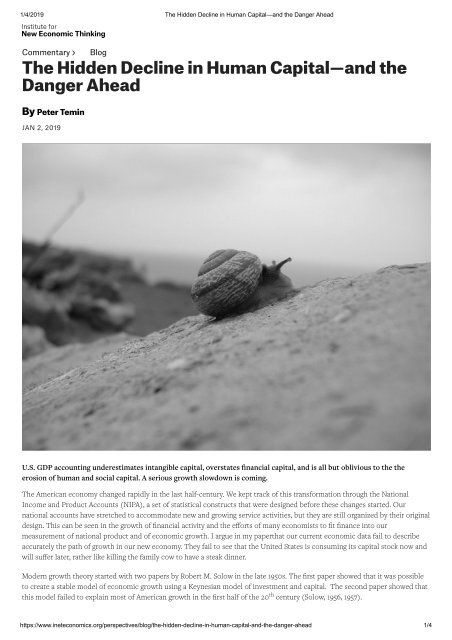Create successful ePaper yourself
Turn your PDF publications into a flip-book with our unique Google optimized e-Paper software.
Christopher Wood christopher.wood@clsa.com +852 2600 8516<br />
Figure 16<br />
US personal interest payments<br />
360<br />
340<br />
320<br />
300<br />
280<br />
260<br />
240<br />
220<br />
200<br />
180<br />
(US$bn, saar)<br />
US personal outlays: Personal interest payments<br />
2000<br />
2001<br />
2002<br />
2003<br />
2004<br />
2005<br />
2006<br />
2007<br />
2008<br />
2009<br />
2010<br />
2011<br />
2012<br />
2013<br />
2014<br />
2015<br />
2016<br />
2017<br />
2018<br />
Note: Consists of nonmortgage interest paid by households. Source: US Economic Analysis<br />
The conclusion remains, therefore, that the growth trend in America will start to converge with the<br />
weakening growth that has already been evident elsewhere. This global slowdown can be seen in<br />
charts of OECD leading indicators and global PMIs. Thus, the JPMorgan Global Manufacturing PMI<br />
declined from 52 in November to 51.5 in December, the lowest level since September 2016 (see<br />
Figure 17), while the OECD Composite Leading Indicator fell to a six-year low of 99.36 in October<br />
(see Figure 18). It can also be seen in the contraction in the German and Japanese economies last<br />
quarter and, most importantly, in the related continuing slowdown in China.<br />
Figure 17<br />
JPMorgan Global Manufacturing PMI<br />
57<br />
56<br />
55<br />
54<br />
53<br />
52<br />
51<br />
50<br />
49<br />
48<br />
(DI)<br />
Global Manufacturing PMI<br />
Jan-10<br />
Apr-10<br />
Jul-10<br />
Oct-10<br />
Jan-11<br />
Apr-11<br />
Jul-11<br />
Oct-11<br />
Jan-12<br />
Apr-12<br />
Jul-12<br />
Oct-12<br />
Jan-13<br />
Apr-13<br />
Jul-13<br />
Oct-13<br />
Jan-14<br />
Apr-14<br />
Jul-14<br />
Oct-14<br />
Jan-15<br />
Apr-15<br />
Jul-15<br />
Oct-15<br />
Jan-16<br />
Apr-16<br />
Jul-16<br />
Oct-16<br />
Jan-17<br />
Apr-17<br />
Jul-17<br />
Oct-17<br />
Jan-18<br />
Apr-18<br />
Jul-18<br />
Oct-18<br />
Source: IHS Markit<br />
In the specific case of China, it is important to highlight again that the critical driver of the<br />
slowdown has not been Fed tightening but domestic policy, in terms of the central government’s<br />
ongoing deleveraging campaign to squeeze the shadow banking sector. This squeeze has been<br />
underway since 2016 and is now probably past its peak, as in part signalled by the statement made<br />
following the annual Central Economic Work Conference (CEWC) held in late December. The<br />
statement said: “China will strengthen countercyclical adjustments in its macro policy, continue to<br />
implement proactive fiscal policy and prudent monetary policy, make pre-emptive adjustments and<br />
fine-tune policies at the proper times”. Targeted easing measures announced at the end of the<br />
Thursday, 3 January 2019 Page 9
















